On April 12, we are celebrating the 125th anniversary of the birth of Kanysh Satbayev, a prominent geologist and the president of the Kazakh Academy of Sciences. In light of this occasion, Qalam reflects on how the Soviet regime accused the pioneer of modern Kazakh science of being associated with Alash-Orda and supporting nationalists.
Vain hopes
The USSR’s WWII victory led to euphoria. Everyone was expecting change and believed in it. Those hopes turned out to be in vain though. It is true that during the war the regime allowed some ideological relaxation of rules, first of all concerning religion and pre-Bolshevism history of the country that stopped being painted black. Apart from that, hundreds of thousands of people gained a different, non-Soviet life experience. Some found themselves inside occupied territories, some as prisoners of war, and many marched across Eastern and Central Europe. “After returning to a peaceful life the authorities tried to regain strict control over people’s minds.”i
Many researchers attribute the toughening of the regime after the war to two factors: Stalin’s obsessive suspiciousness, which basically stained all his rule, and the start of the Cold War. Formally the starting point of the Cold War was Churchill’s speech in Fulton in the Spring of 1946. In the speech Churchill proposed creating a union of Anglo-Saxon countries in order to fight Communism. The USSR in turn identified “Anglo-American Imperialism” as the main outside threat and kowtowing to the West as the main inside threat.i
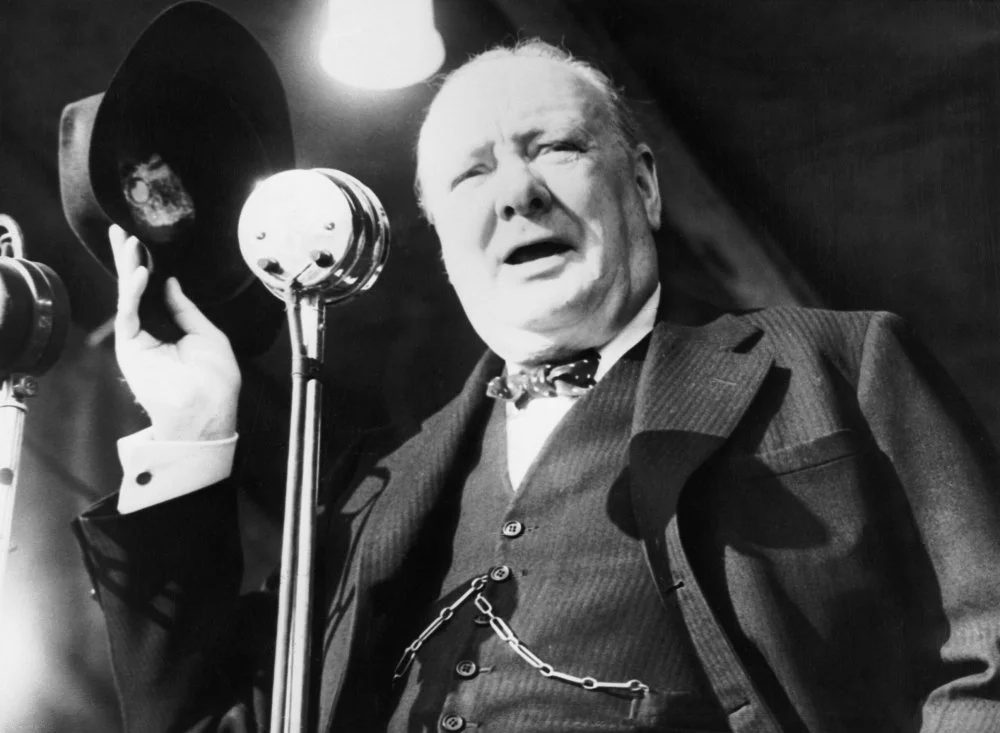
The 1945 General Election: Winston Churchill giving his final address, during the election campaign, at Walthamstow Stadium, East London/ Imperial War Museums/Wikimedia Commons
On the 14th of May 1947 during a meeting with writers Stalin said (as recorded by Konstantin Simonov1

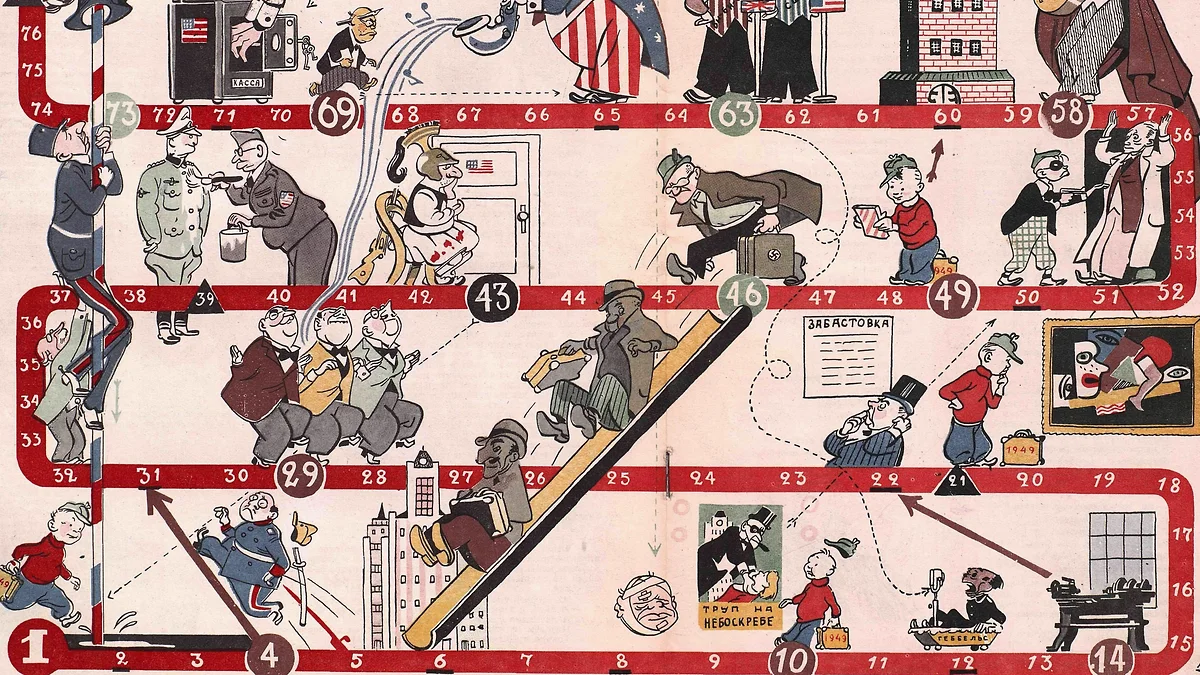
Illustration from the magazine "Crocodile", 1948, No.36 Figure: Yu.Ganf/from open access
The fight against “cosmopolitism”2



Soviet poster of 1947/Wikimedia Commons
During mid to late 1940s Stalin started to develop a concept that was about all ethnic outskirts joining Russia at an exceptionally progressive pace. This in turn led to a revision of the history of the Russian Empire. Historians were strongly recommended to “show the truly progressive aspect of the historical input of the Russian people into the history of humanity”. Any other view of national history became impossible. The aftermath of this policy were limitations in studying national culture, both material and spiritual. The middle classes, whose scientific or creative interests did not quite match the official canons got crushed under the roller of the repression machine. The fight against nationalism (just like the fight against national deviation in the 1920s and 1930s) became one of the prioritised tasks of the Party during the last years of Stalin’s rule.
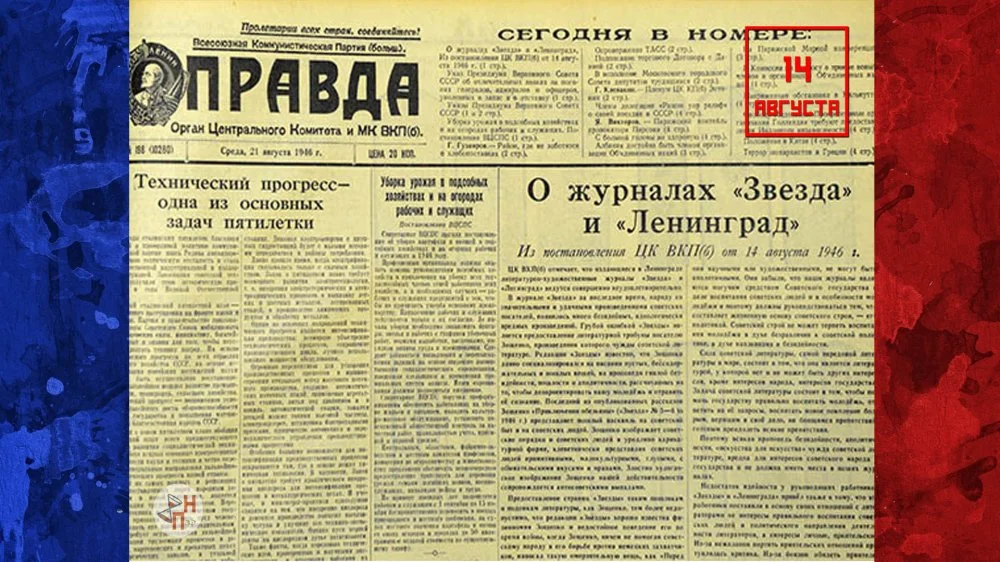
A clipping from the newspaper Pravda/Wikimedia commons
This was taking place alongside a full-scale attack on the middle classes with the aim of suppressing any creative or ideological autonomy. Starting from 1946 several political orders were made: “About Zvezda and Leningrad magazines”,3




Academician Kanysh Satbayev looks at the mineral stone/Wikimedia Commons
File № 335
When working at the Russian State Archives of Social and Political History (RSASPH) with the documents from Fund 17 (from the Central Committee of the Communist Party) we studied file № 335, started in 1950 and titled “Notes and references of the department and sector of science on reports …about facts demonstrating nationalism within the Academy of Acience and other scientific bodies of Kazakh SSR”.i

However not all of the documents attracted the attention of the authors. What was the direct cause of the attack aimed at the Kazakh Academy of Science and K.I.Satpayev himself? The textbook answer can be found pretty much in all of the research documents covering the history of Stalin’s post-war decade: there were several orders from the Central Committee of the All-Union Communist Party of the Bolsheviks (CCAUCP (b)) almost immediately followed by the orders by the Central Committee of the Communist party of the Bolsheviks of Kazakhstan in 1947.i
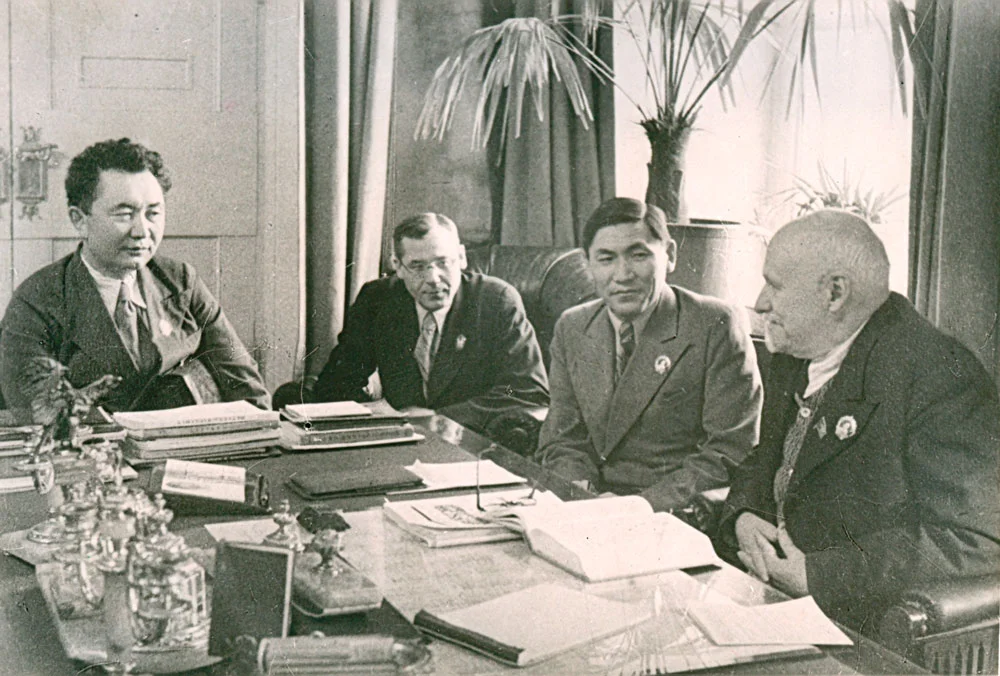
Scientists during the discussion of the opening of the Academy of Sciences of the Kazakh SSR. From left to right: Chairman of the KazFAN of the USSR K.I. Satpayev, V.A. Bely, Chairman of the Council of People's Commissars of the Kazakh SSR N.D. Undasynov, President of the Academy of Sciences of the USSR V.L. Komarov. 1945 /e-history.kz
In his notes K.I. Satpayev speaks about the results of the work of the KSSR Academy of Science: if in 1941 the Kazakh branch of the USSR Academy of Science had 100 academic staff, 14 of which held master’s degrees and 3 had completed a doctorate, by 1947 the KSSR Academy of Science had 1580 staff (including branches), with 83 PHD and 220 masters degree staff. K Satpayev also pays special attention to the growth of national academic staff, and by 1950 24.9% of staff were Kazakhs with academic degrees.i
The hallmark of post war repressions is “the clear personalisation of political allegations”.i
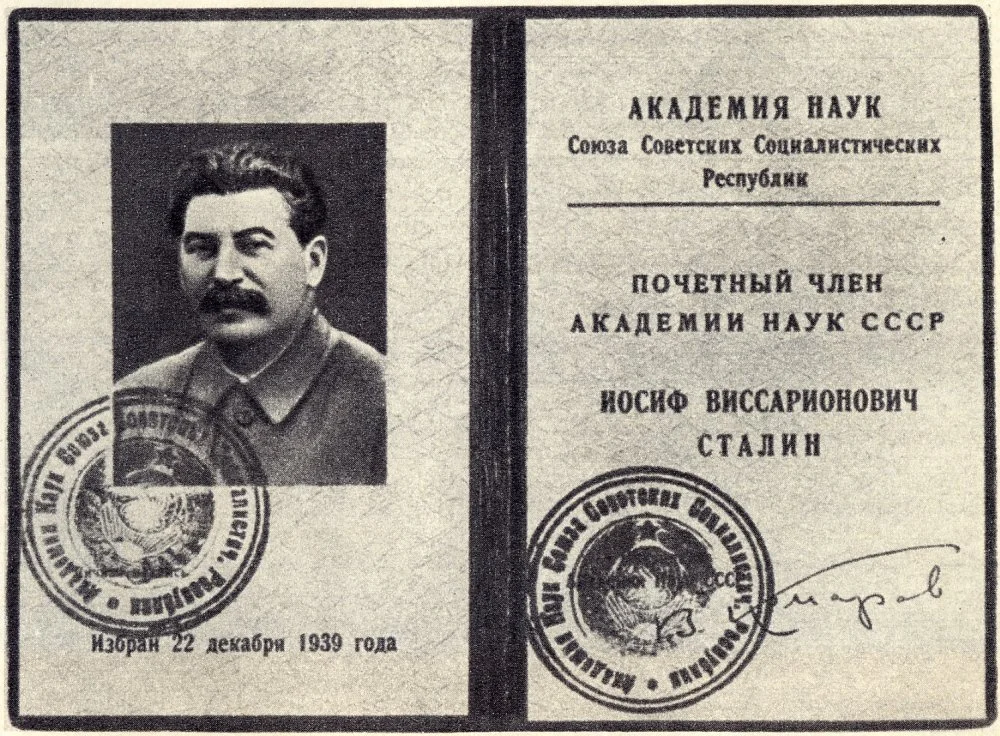
Joseph Stalin’s honorary member of the Academy of Sciences of USSR certificate. from "Ogonyok" magazine, March 15, 1953, # 11 (1344)/Wikimedia commons
Without removing responsibility from Stalin’s repression machine and without condoning its actions we feel that it is important to note that when researching repressions, the role of specific informers is overlooked. We are convinced that had Kazakhstan not had so many informants’ letters the fates of at least some, and possibly hundreds, of people would have been different and not quite so tragic. We think the responsibility of these “sycophants”i
M.K Kosybayev gives a very clear definition to the role of these historians and the consequences of their publications in the “Bekhmanov file”, calling them “disastrous” for historical science of Kazakhstan.i
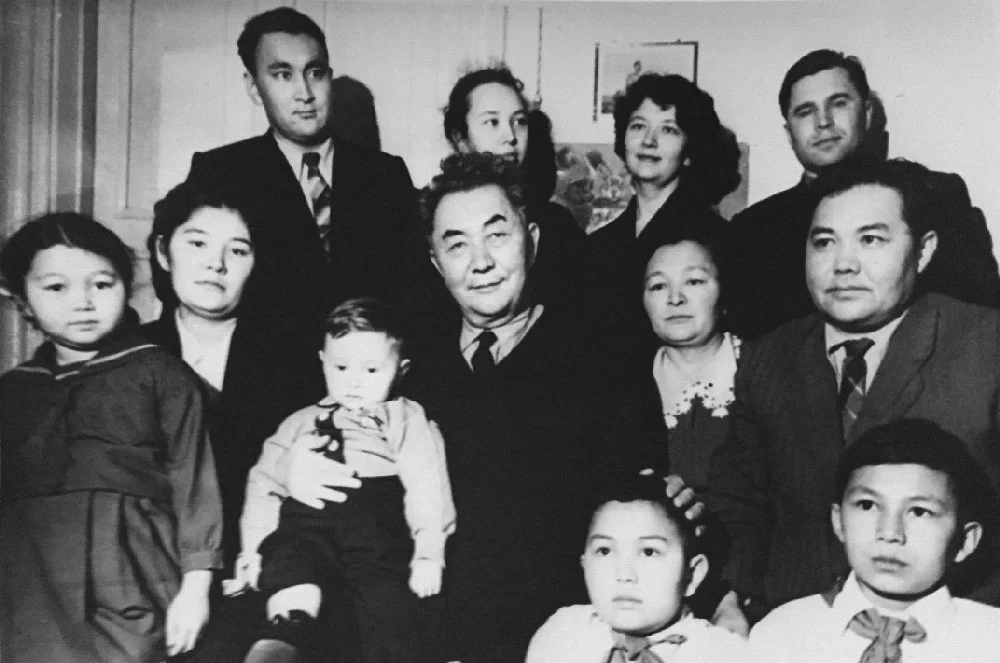
Academician Kanysh Satbayev with his family/Wikimedia Commons
Let us go back to file № 335. In June 1950 CCAUCP(b) organised audits at the Academy of Acience of Kazakh SSR, the result of which was a note addressed to the secretary of CCAUCP(b), G.M. Malenkov, signed by the inspectors P. Apostolov, B Mitreykin and A. Pewtrovski. They noted that “reported facts were mostly confirmed during the audit”.i
Here are some extracts from this note from the file № 335 just so it is easier to understand what facts they were talking about:
“The Central Committee of the Communist Party of Kazakhstan has mentioned more than once in its directives that some academic staff cultivate harmful and ideologically malpositioned guidelines, idealising feudal clans, glorifying Khans and Bais and blurring over the class struggle in the pre-revolution Kazakh aul, as well as promoting bourgeois, nationalistic and anti-Russian views.”
CCCP (b) of Kazakhstan also often instructed the management of the Academy of Acience to remove from the Academy those individuals who were not politically trustworthy and unable to perform academic work. However, all those mistakes and perversions were still repeated by many other academic staff, as well as artists and cultural professionals of Kazakh SSR, and were not met with the same political evaluation from the CCCP (b) of Kazakhstan.
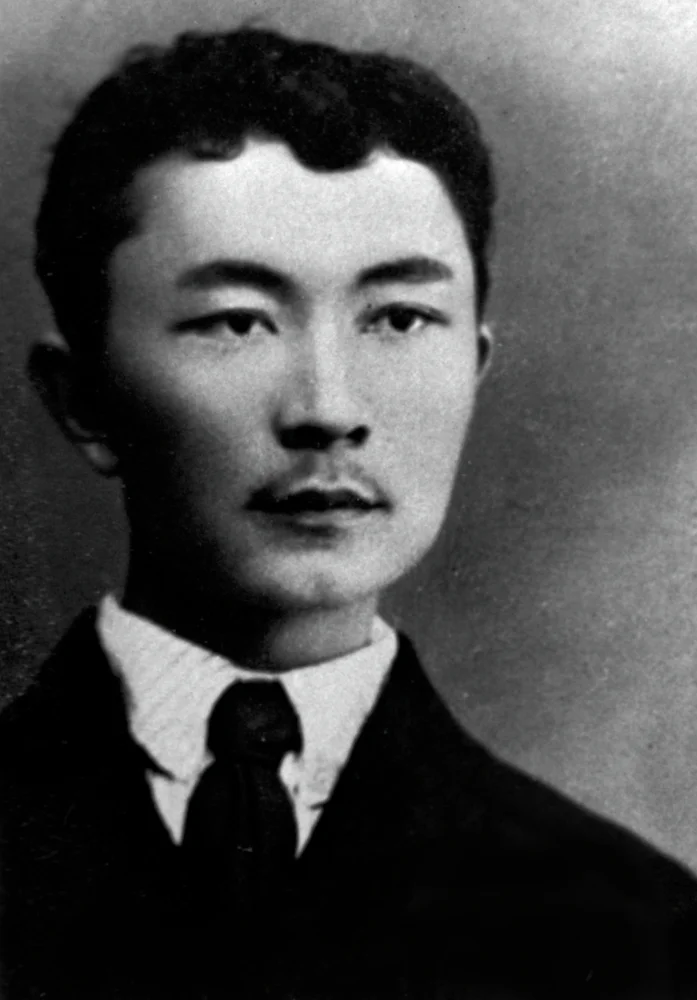
Kanysh Satpayev when he was a student at the Tomsk Institute of Technology. The year is 1929. Reproduction of a photo. The original is located in the State Historical Museum/RIA Novosti
For example, Bekhmanov, the author of the book “Kazakhstan in the 20s and 40s of the XIX century” still continues to support erroneous views towards the nature and essence of the uprising of Kenesary Kasymov.7



Members of Alash party in Semipalatinsk, 1918/Wikimedia commons
“…in 1950 the Academy of science of Kazakh SSR published a book by Akisheva titled “Confiscation of cattle and possessions of prominent semi-feudal bais in Kazakhstan” This book contains angry anti-Soviet bai quotes, gives numerous negative examples of the poor taking part in bai banditism. Due to the book being deemed politically harmful it was withdrawn on the orders of CCCP (b) of Kazakhstan. Another book withdrawn in 1950 was the book by Pogorelskiy titled “Settling of nomads and development of livestock farming in Kazakhstan” in which the author claims that “nomands ancestry is not the one that we have learned about according to Marx and Engels but the one described by Radlov”.9


“...The book of the current member of the academy of science of the Kazakh SSR Zhubanov contains openly nationalistic tendencies. In this book, masked as folklore research, the “singing” and “sounding” pre-revolution history of the Kazakh people in song is told from a biased and anti-Russian point of view”i
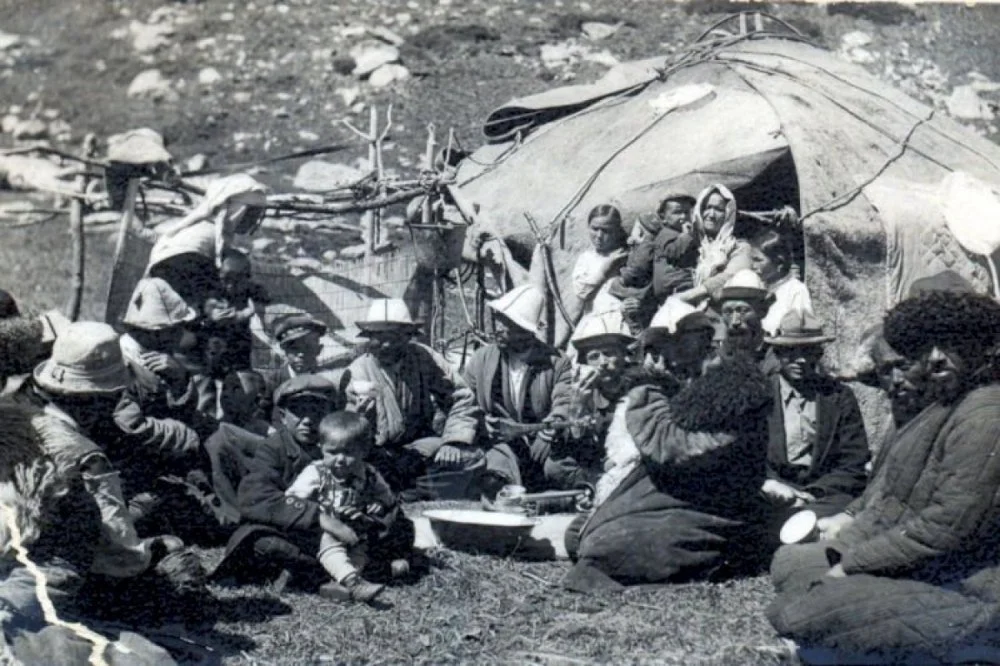
A shot from the documentary "Asharshylyk 1933" about the famine in Kazakhstan/from open access
“…Stated facts are testimony to trouble at the ideological front. One of the reasons for this is the impurity of staff in scientific and cultural institutions of Kazakhstan. Due to numerous orders from CCCP (B) of Kazakhstan, despite the resistance of the Academy of Science president Satpayev, in just 3 years over two hundred and fifty people were fired from the academy. Upon inspection it was concluded that the staff of the Academy of Science is still polluted by people who are not trustworthy and not capable of scientific and research work”.i
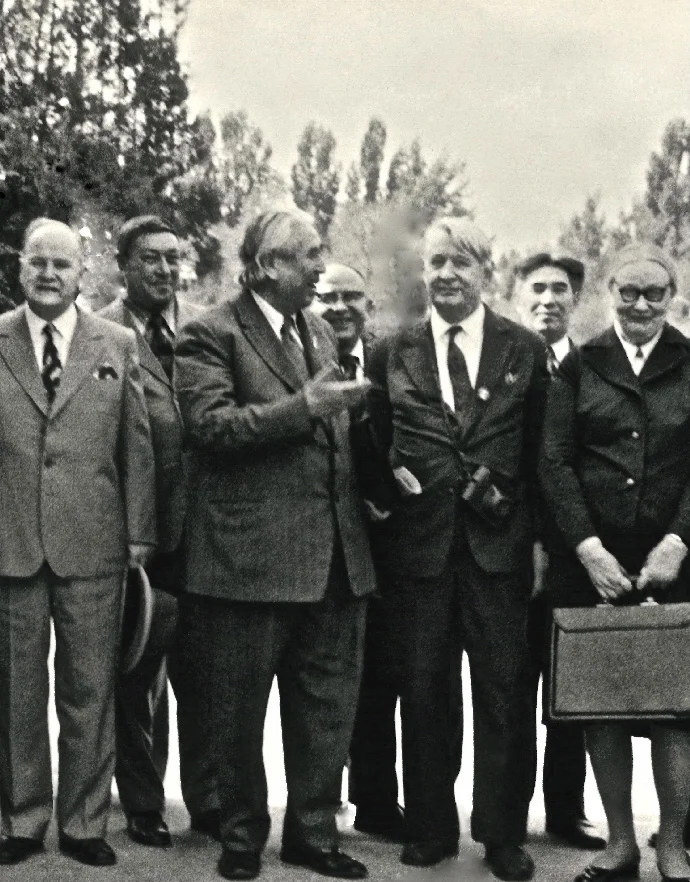
Presidium of the II All-Union Turkological Conference (from left to right): academician A. N. Kononov, professors B. Ch. Charyyarov, S. K. Kenesbaev, Yu. D. Desheriev, N. A. Baskakov, G. H. Akhatov, E. I. Ubryatova. Almaty, 1976/Wikimedia commons
The note by the Central Committee instructors mentions “nationalists”, “Trotskiysts”, “enemies of the people” and names the “pests”: Margulan, Bekturov, Stender< Songina< Tartakovskaya, Snopova, Ermrkovy, Tarabayev, Professor Rusakov, Letnikov, Kenesarin, Kondybaev, Galitskiy etc. “…Numerous facts confirming the pollution of the Kazakh SSR Academy of Science by politically alien individuals are not a coincidence – note the inspectors of CCAUCP(b) – ruling members of the academy presidium: vice president Kenesbayev (Son of a Bai), member of the Academy and secretary Galuzo (brother of a Trotskyist) do not inspire political trust… The Academy of Science president K Satpayev also comes from a family of a very prominent Bai. Two of his brothers were purged as enemies of the Soviet regime. Satpayev does not disclose to the party the fact that in 1918 he actively participated in the work of the counter-revolutionary bourgeois nationalistic party “Alash-Horde” … Due to upcoming discussion of the data obtained during the audit at the bureau of Kazakhstan CCCP (B) it is considered necessary to add a suggestion about renewing the management of the Kazakh SSR Academy of Acience.”i
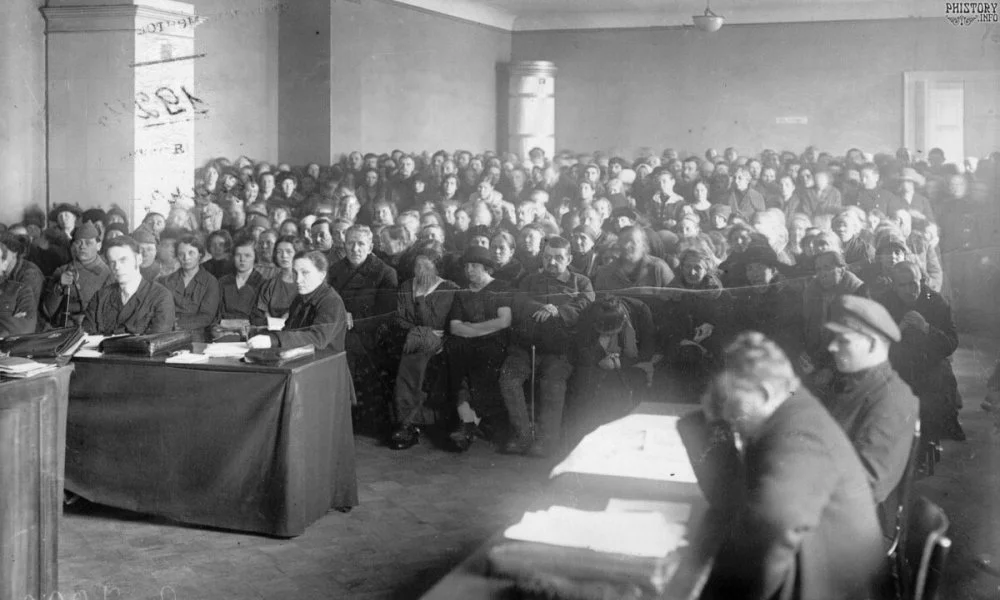
The Court of the 1920s in the USSR/from open access
Following the inspection carried out by P. Apostolov, B. Mitreikin and A. Petrovsky, the President of the Academy of Science KSSR K. Satpayev had to submit a statement report on 67 pages to the secretary of CCCP (b) of Kazakhstan Zh. Shayakhmetov and deputy chief of the Department of Propaganda of the CCAUCP (b) V. S. Kruzhkov.i
The allegations kept coming against the Academy and Satpayev. A certain A. Mitin sent an informant note in September 1950, addressed to the deputy of the Propaganda Political Activism Department of CCAUCP(b) V. S Kruzhkov, in which he states that “Comrad Satpayev in his letter tries to discredit the work of the Propaganda Department sectors as well as the work of Party, trade union and Komsomol bodies of CCAUCP(b), and comrades P. Apostolov, V Mitreikin and Petrovskiy. Satpayev thinks that the CCAUCP(b), did not provide any assistance to the work of the Kazakh SSr Academy of Science. The team did not and could not be tasked with providing any help to the Academy. Comrades Apostolov, Mitreikin and Petrovsky went to the Kazakh party organisation following orders by CCAUCP(b), with the purpose of investigating the reports by Chernichenko and Shoinbayev (Highlighted by us).i
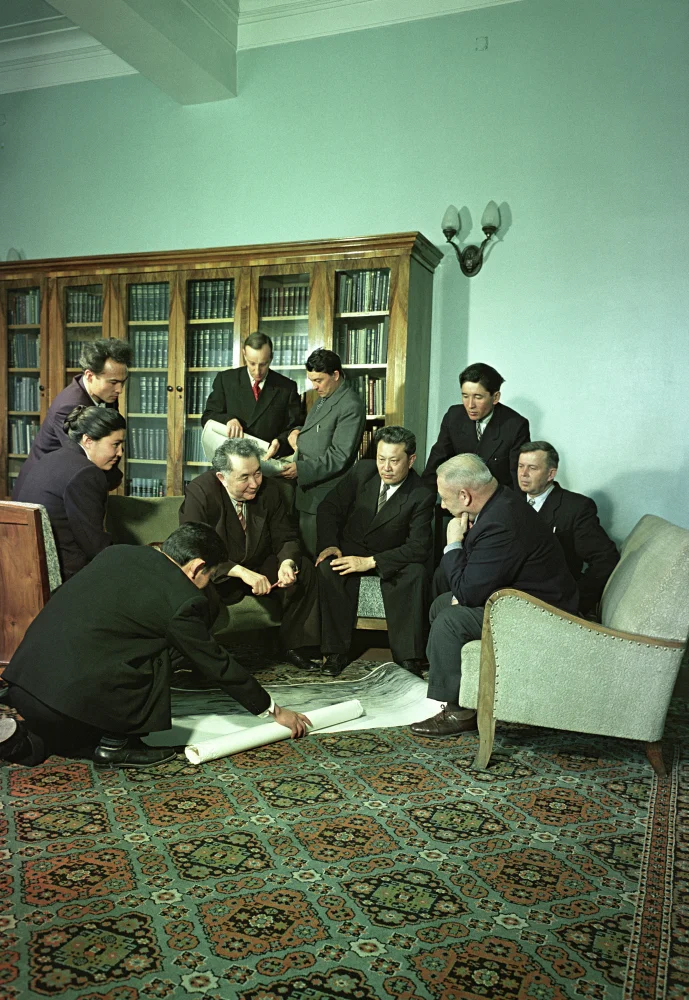
The Kazakh SSR. The city of Almaty. Institute of Geological Sciences of the Academy of Sciences of the Kazakh SSR. Academician Kanysh Satpayev with a group of employees at the map of the future channel 03/01/1960/Joseph Budnevich/RIA Novosti
What is written in the denunciation of Satpayev?
From this document it finally becomes apparent who triggered the checks on the Academy of Science of Kazakhstan. The initial impulse came from Chernichenko and Shoinbayev. A. Chernichenko was a newspaper reporter for “Pravda” in Kazakh SSR. T. Shoinbayev was a candidate for Historical Science. Shoinbayev wrote two reports on K Satpayev. The first became a reason for the inspection by P. Apostolov, B Mitreikin and Petrovsky. The second one was sent by T. Shinbayev in October 1950 addressed to the secretary of CCAUCP(b) M.A. Suslov, and also to the committee of the Party control of the CCAUCP(b) addressed to M.F. Shyryatov. 67 years later it is difficult to talk about motives that made a professional historian and candidate for Historical Science to write “letters” of this sort, but it is not a coincidence that publications that mention these events speak of “haters and enemies”, and it is not implausible that these definitions explain the reasons for writing such “reports”. It is important to know the consequences these reports led to. Even though the majority of the “facts” stated in these letters were insinuations, they still triggered the new era of the victimisation of Satpayev.
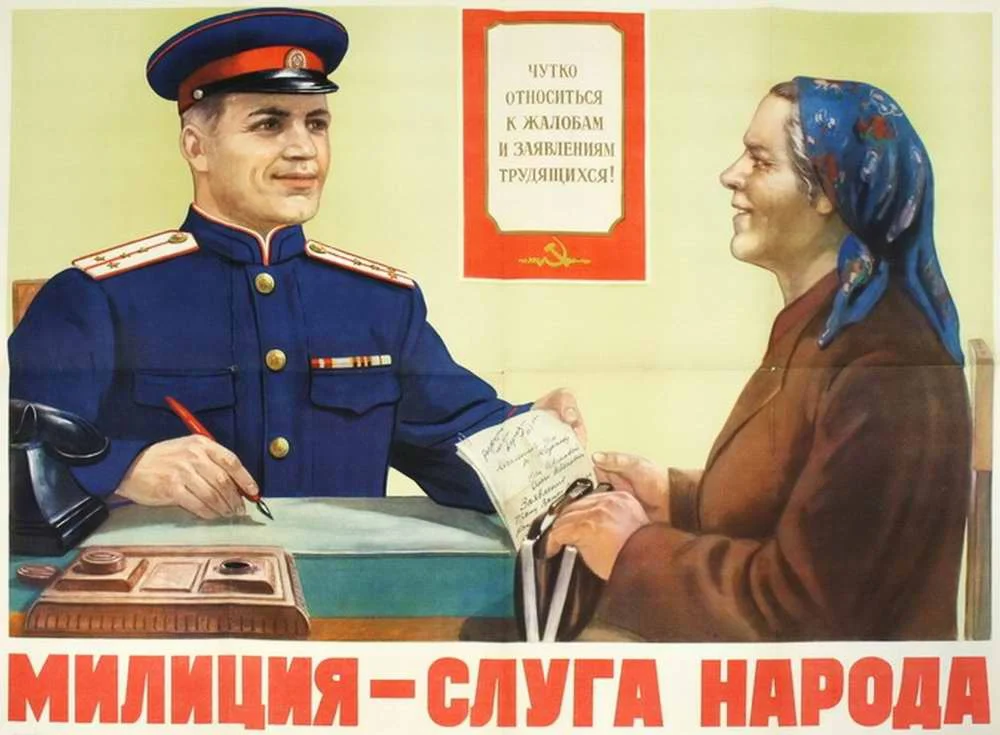
A poster from the 1950s/Wikimedia commons
In the new report by Shoinbayev he does not mention the academic’s business qualities or his own concern about the state of Kazakh science. This letter is simply an ф denunciation. Out if its 7 pages 4 are dedicated to K. Satpayev’s “Alash” past, half a page to the accusations of Satpayev supporting the concept of E. Beckmetov about the Kenesara movement; and 2 pages are just his speculations about the protection of Satpayev by the “elements socially distant to the Soviet regime”, followed by a list of questions which according to T. Shoinbayev need special checks. These points, highlighted as key information in Shoinbayev’s letter, are quite demonstrative (and somewhat typical in letters of this sort) of the Stalin era: ancestry and roots (participating or not participating in political battles, party opposition, “national deviationism” etc.) played the key role.
It is important to note that although this letter was dated October 1950 the facts contained in it were quoted almost word by word in a letter by the instructors of the Propaganda and Campaigning Department of CCAUCP(b) in June 1950. It would seem that dissatisfaction of the results of the party audits of the Academy of Science prompted T. Shoinbayev to “write” again.

Akhmet Baitursynov's prison photo (one of the last photos). 1937/Wikimedia commons
Let us give some examples of Shabatev’s insinuation (dated October 1950) here; it starts with a description of “bourgeois nationalistic” party “Alash” (the spelling of the letter is preserved ): “In July 1917 in Orenburg during a so call pan-Kirgizstan congress that was held under the management of nationalist cadet Bukeikhanov and consisting of Bays, Mullahs and representatives of bourgeois nationalistic middle classes, the counter revolutionary, bourgeois nationalistic party under the name of "Alash” was formed politically with branches in other cities and towns of Kazakhstan.
The ”Alash” party was the secret service of the Russian imperialist bourgeoisie, supported the interim government and fought against Bolshevik revolutionary influence penetrating the indigenous population.
The “Alash” party was the enemy of the Soviet regime, and therefore of the Kazakh people. During the war for to establish Soviet regime in Kazakhstan hundreds of Bolsheviks and non-party members Bolsheviks who were Russian, Ukrainian and Kazakh died at the hands of Alash- Horde executioners. They also killed the Bolshevik hero of the civil war Amangeldy Imanov, who was a relentless fighter for the Soviet regime in Kazakhstan”.i
As we can see, there was nothing new and nothing of his “own” in the interpretation of events that happened many years before by the author of the letter; he just mechanically put forward the official point of view of the times at which the letter was written concerning events that happened 30 years ago.
Further in the letter: “One of the active members of this “Alash” party was the current president of the KazSSR Academy of Science Kanysh Satpayev. This can be confirmed by the writer Mukhtar Auezov. This is also confirmed by the newspapers “Kazakh” and “Sary-Arka” – belonging to the “Alash” party. On the pages of these newspapers one can find the surname of Satpayev among other Alash- Horde members. For example, in the “Sary-Arka” newspaper from the 9th of November 1917 numbered 19, in the article titled “Propagandist” it was stated that Kanysh Satpayev and Djusupbek Aimautov were sent by the “Alash” party to visit Pavlodarsky county to carry out anti-Soviet propaganda among the Kazakh people. Aimautov was also one of the active members of this party, later exposed as an enemy of the people. Kanysh Satpayev zealously carried out the tasks set to him by the “Alash” party in the fight against the Soviet regime and due to this an article praising him was published in one of the issues of the “Kazakh” newspaper in 1918. The article stated that the “Alash” party places great expectations on their young member Kanysh Satpayev who is extremely loyal to the cause of the “Alash” party. Satpayev’s loyalty to this bourgeois nationalistic party was not accidental. He was from a large B ay feudalistic family. He dreamed of preserving the Bay regime over the Kasakh people and the “Alash” party was protecting the interests of the Kazakh people. It was also not a coincidence that his brothers Abikei, Karim and Nokesh were also active members of this party helping fight against the Soviet regime.. After the establishment of the Soviet regime in Kazakhstan the ‘Alash” party went deep underground. Alash-Horde members, having failed, scattered all over the place. They changed their tactics and became quiet, compliant and tame - reasonable “Soviet” people.”i
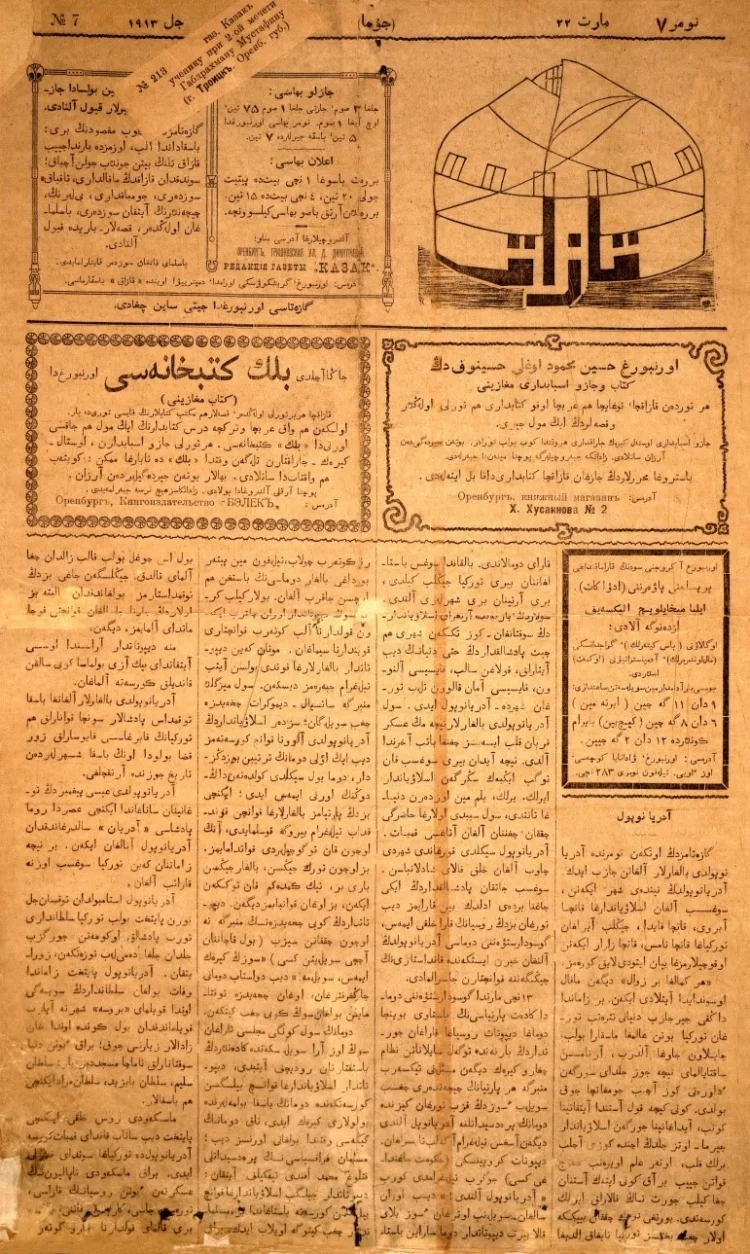
7th issue of the Kazakh newspaper dated March 22, 1913/Wikimedia Commons
In this part of the letter the author is clearly being very economical with the truth: as a historian, he could not have been unaware that representatives of the “Alash” party were granted amnesty by the Soviet regime and all of them without exception were engaged by the same party.”
Further in the letter: “Kanysh Satpayev had nothing else left to do but turn into a normal “Soviet person”, trying to save his neck he began his studies in Tomsk. The other Satpayevs, brothers Abikei, Karim and Nokesh did not quite manage to blend in as well as their brother Kanysh. They were exposed and purged by the regime as enemies of the people. Kanysh Satpayev was unlikely to forgive the Soviet regime for this. In 1945 the former member of the counter-revolutionary party “Alash”, bourgeois nationalist, and enemy of the Bolshevik party Kanysh Satpayev was accepted into the All-Union Communist Party of the Bolsheviks AUCP (b). He hid the fact that he used to be and still was a bourgeois nationalist and that he came from a feudalist family. He only partly admitted that all Satpayev family members from big to small fought the Soviet regime.

Kanysh Satpayev, 1960/Joseph Budnevich/RIA Novosti
i
Shoinbayev juggles the terms “Bay” and “Well-to-do cattle farmer”, and accuses the Academy member of hiding his real age, because he knows very well that the readers of his letter are very far removed from the realities of Kazakh society. Today (when almost seventy years have passed) it is difficult to tell if Shoinbayev was lying or actually believed all he was writing in his letter about Satpayev’s age, however as a professional historian he simply could not be unfamiliar with the social categories of Kazakh society before the revolution. Shoinbayev later moves on to allegations against Doctor of Historical Science, Professor E.B. Bekmahanov.
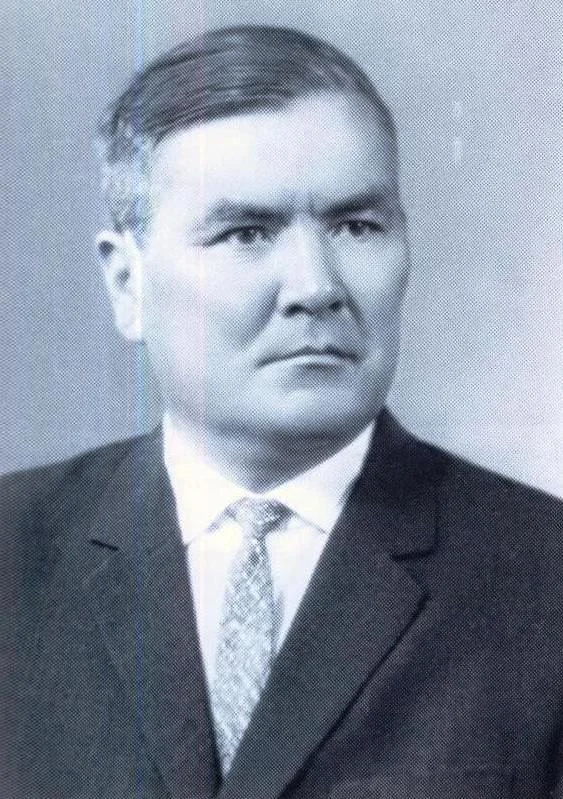
Ermukhan Bekmakhanovich Bekmakhanov, Kazakh historian/Wikimedia Commons
“Kanysh Satpayev never ceased to be a bourgeois nationalist, even now. This is supported by the fact that he was zealously defending the bourgeois nationalistic views of BEKMAHANOV, put forward by the latter in his book “Kazakhstan in the 20s and 40s of the XIX century”. In this book Bekmahanov idealised the arch enemy of the Kazakh people, agent of the khans of Central Asia and English Imperialism, Sultan Kenesara Kasymov. In Bukeikhanov’s book the works of nationalist cadet Alikhan Bujeikhanov are also praised. All of this was of course to Satpayev’s liking, and this is why he defended Bekhamanov and his bourgeois nationalistic book with an excess of zeal”.i
The next list of allegations is to do with K.Satpayev’s personell policy.
“With Satpayev’s help a number of individuals from bay-feudalistic families became academics, doctors of science, and some even members of the Academy. For example, the daughter of a prominent bay, wife of a bourgeois nationalist Tarabayev, having all of the favourable conditions created by Satpayev at her disposal, became a doctor. A brother of another bourgeois nationalist, Alash-Horde member Gabbasov, became an associate member of the Academy of Science. Satpayev’s brother in law, Berkutov, the husband of the daughter of Alash-Horde member Abikei Satpayev, became a full member of the Academy of Science, and his wife Raikhan, sister of Satpayev and daughter of the arch enemy of the Kazakh people became a candidate of science.i

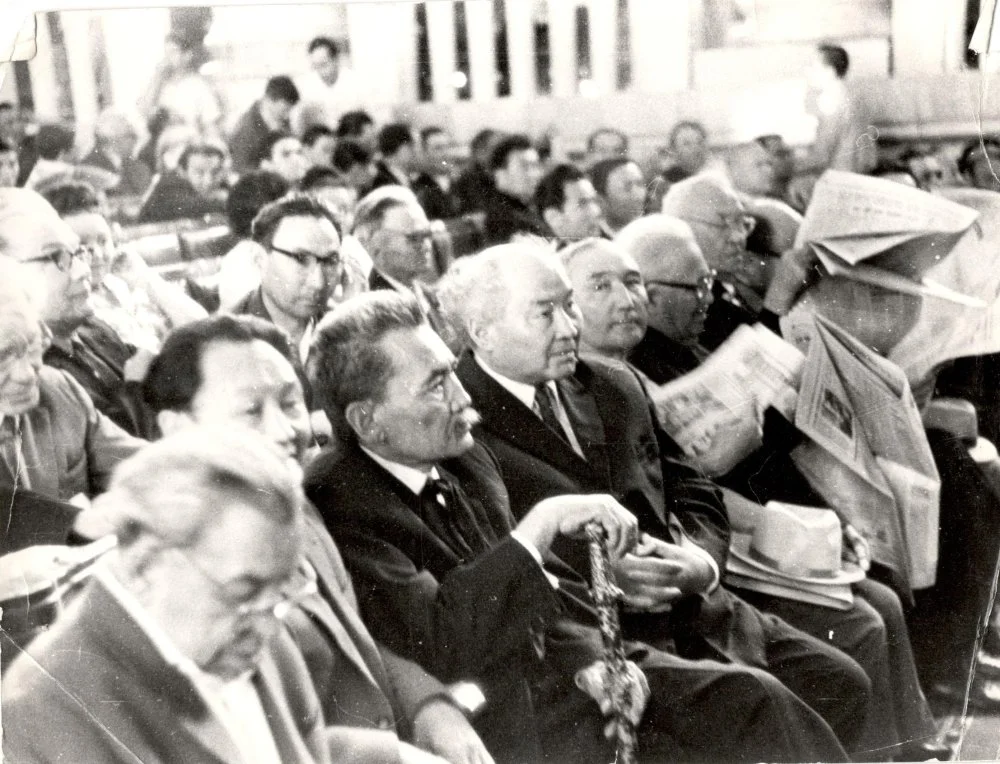
Baurzhan Momyshuly and Alkey Margulan are attending writer's summit. At the Congress of the Union of Writers of Kazakhstan, 1982/Wikimedia Commons
The fate of Satpayev after the denunciation
The content of the letter of T Shoinbayev evokes a synonymous reaction, but it is not just about emotional evaluation. T. Shoinbayev’s letters could have played a disastrous role in the life of Satpayev. The first part of the allegations against K. Satpayev referring to his non proletarian bay origin and concealing of such could have threatened him with Clause 58 of the Criminal Сode.i
23 ноября 1951 by the decision of the meeting of the bureau of the Central committee of the Communist Party of the Bolsheviks charges were brought against Kanysh Satpayevi



Zhumabai Shayakhmetovich Shayakhmetov, NKVD officer, later First Secretary of the Communist Party of the Kazakh Ssr in the 1940s/Wikimedia Commons
It is difficult to imagine what could have happened had Stalin not died a year and a bit later. It is possible the “Satpayev case” would have become the trigger for mass purges aimed at all of the national elite of Kazakhstan. Who knows? The trajectory of all of Stalin’s personal purges always developed in the same way: removal from post of the one accused of serious “errors of judgement” – brief period of calm – criminal prosecution – finding hidden allies and supporters at the person’s place of work, inside a party and its’ apparatus – execution by shooting of the main characters and long exile for the rest including family members.
His biographer M. Sarkseev writes that copies of three letters, written between January and March of 1952 are stored in Satpayev’s archives: first letter dated 20th of January and addressed to I.V. Stalin (55 pages), the second one addressed to the secretary of the Central Committee of All-Union Communist Party of Bolsheviks, G.M. Malenkov (5 pages), and the third one to the head of the Science and Universities department of the CCAUCP (B) Y.A. Zhdanov (on 8 pages).i

What to read
Академик К.И. Сатпаев: Сборник документов и материалов. Составители Б.Т. Жанаев и др. Астана: 1С-Сервис, 2009. 560 с.
Верт Н. История советского государства. 1900-1991. М.: Прогресс-Академия, 1992. 480 с.
Гринберг И. Идеологические кампании в послевоенном СССР их их последствия для Казахстана// Казахстан: послевоенное общество 1946–1953 гг. Материалы Международной научно-практической конференции. 20 апреля 2012 г./ под ред. Х.Абжанова и др. А-А: «Арыс», 2012. С. 119-135.
История Казахстана (с древнейших времен до наших дней). В пяти томах. Т.4. А-А: Атамура, 2009. 680 с.
Политические репрессии в Казахстане в 1937–1938 гг. Сб. документов. А-А: Қазақстан, 1998. 336 с.
Сарсекеев М. Сатпаев. А-А: Онер, 1989. 447 с.
Сталин И. о преклонении перед иностранцами, 1947 г.
Архив Президента Республики Казахстан (АП РК). Ф.708. Оп.15. Д.175а. Л.1.
Российский государственный архив социально-политической истории (РГАСПИ). Ф.17. Оп.132. Д.335. Л.1-120.
